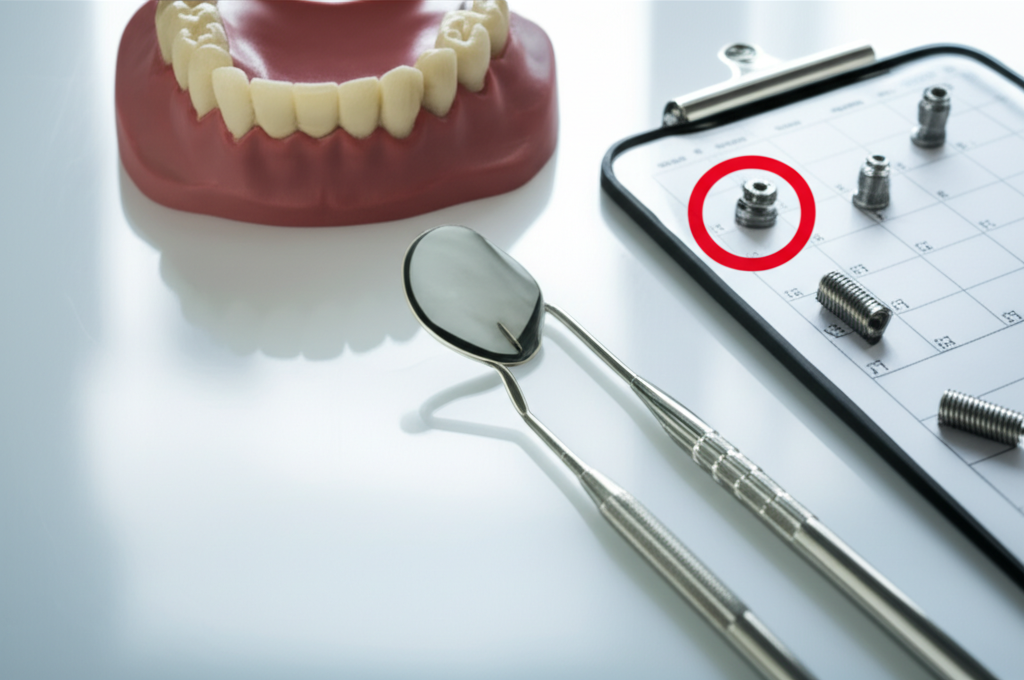
What Is the Timeline for Getting Dental Implants? Your Step-by-Step Guide
That Big Question: “How Long Until I Have My New Tooth?”
You’ve probably heard about dental implants—they’re the best modern way to replace missing teeth. But here’s the real question on your mind: How long does it really take to get dental implants, from beginning to end? If you’re picturing a fast fix, you might be surprised. And if you’re feeling confused by all the steps, words, and timelines, you’re definitely not alone.
Let’s go through the real timeline for dental implants: what happens, how long each step lasts, and why it all sometimes takes longer than you think. By the end of this guide, you’ll not only understand the steps of the dental implant process, but you’ll also feel ready to take the next step toward your healthiest, happiest smile.
In This Article
- Quick Answer: The Typical Dental Implant Timeline
- Phase 1: First Visit & Planning
- Phase 2: Extra Work Beforehand (If Needed)
- Phase 3: Dental Implant Placement Surgery
- Phase 4: Osseointegration – The Important Healing Time
- Phase 5: Abutment Placement (Second Step)
- Phase 6: Final Crown/Prosthesis Placement
- Things That Change Your Dental Implant Timeline
- Shortest vs. Longest Timelines: Real-Life Examples
- Why Understanding the Timeline Matters
- Who Is a Good Person for Dental Implants?
- Your Healthy Takeaway
Quick Answer: The Typical Dental Implant Timeline
Here’s the quick version, if you’re in a hurry:
Most dental implant journeys take anywhere from 3 to 9 months from the first appointment to your new smile. Need extra work (like bone grafting or a sinus lift)? It can take as long as 12 to 18 months. And in rare cases, “teeth in a day” solutions may be possible if you’re the right person for it.
But why such a big difference? The answer is all about healing time—your body needs time to get better and let the implant join with your jawbone. If someone promises a shortcut, be careful! Rushing the process can risk your money and your health.
Phase 1: First Visit & Planning (1–2 Weeks)
Checking and Imaging
Everything starts here. Think of this as the planning stage for your new tooth (or teeth). During your first visit, your dentist or specialist will:
- Take dental X-rays or a Cone Beam CT scan (CBCT) to get a 3D picture of your mouth and jaw.
- Do a close look at your mouth—checking the health of your gums, jawbone, and the teeth nearby.
- Ask about your health history, medicines, and habits like smoking or diabetes, as these can affect how you heal.
Making a Treatment Plan
Your dental team will explain to you:
- The specific steps needed for you (everyone is different)
- Choices for numbing and comfort (local anesthesia or sedation)
- Number of appointments needed and time between them
- A rough idea of the how long the dental implant process will take for your case
Dealing with Other Health Problems
Sometimes, your dentist will need to treat gum disease, infections, or tooth decay before going forward. Taking care of these early gives your implant the best chance to work.
Typical timeline for this phase: 1–2 weeks, maybe longer if you need to heal after treating other problems.
Phase 2: Extra Work Beforehand (If Needed – 4–12+ Months)
Not everyone needs these steps, but they’re common and can add months to the timeline. Why? Your jaw needs a strong, healthy base for implants to work.
Tooth Removal (If Needed)
- Why: If your tooth is broken or failing, it will need to be taken out.
- Healing time: 2–4 months for the bone to fill in and get strong, unless an immediate implant placement is possible.
Bone Grafting
If your jawbone is thin, too soft, or has gotten smaller over time, your provider might suggest a bone graft. This is like making the foundation stronger before building a house.
- Types: Choices include your own bone (autograft), donor bone (allograft), or man-made graft materials.
- Healing time: Anywhere from 4–12 months, depending on the type and how much is needed. The average is about 6–9 months.
Sinus Lift (For Upper Back Teeth)
For implants in the upper jaw (especially where your molars are), you might need a sinus lift—lifting the sinus membrane and adding bone under it to make space for the implant.
- Healing: 4–9 months before an implant can be placed.
Gum Grafting
If your gums have pulled back or are too thin, a small gum graft might be done, with a healing time of a few weeks.
Bottom line for Phase 2: Not everyone needs these, but if you do, the timeline can get much longer. These steps are very important for the dental implant to succeed—skipping them could make the implant fail.
Phase 3: Dental Implant Placement Surgery (1 Day + 1–2 Weeks Recovery)
Here’s where the main part happens: the titanium implant post is placed in your jawbone, working as a new “root” for your future tooth.
The Surgery
- The surgery usually takes 1–2 hours for each implant.
- Local anesthesia numbs the area (sedation is an option if you’re nervous).
- The surgeon makes a small cut in the gum and creates space in the jawbone for the implant.
- The titanium post is “screwed” in place, and sometimes a temporary healing abutment is put on.
Right After Surgery
Expect some swelling, a little bleeding, and soreness for a few days. Most people say the feeling is not as bad as they expected—store-bought pain medicine usually works.
- Diet: Stick to soft foods. Avoid using the implant area for a week or two.
- Mouth cleaning: Keep the area clean, follow your dentist’s instructions to avoid infection.
What to Expect
You’ll get instructions for after the surgery explaining what you can and cannot do. Avoid smoking and heavy exercise—both can affect healing.
Phase 4: Osseointegration – The Important Healing Time (3–6 Months)
Now for the part that’s all about waiting: osseointegration.
What Is Osseointegration?
Here’s a big word for the most important part of the implant process. Osseointegration is when your jawbone grows tightly around the titanium implant, holding it tightly in place—just like roots holding up a tree.
Think of it like putting cement around a fence post. Until it’s set, you can’t put up the fence.
The Waiting Game
- For most people, this takes 3–6 months. If your bone was healthy from the start, it might be on the shorter end.
- If you had a bone graft or sinus lift, it can be on the longer end.
- This time is very important—bothering the implant could make it fail.
Temporary Fixes
You won’t be left with a gap in your smile. Many dentists offer temporary dentures, partial bridges, or even temporary crowns to fill the space while you heal.
Phase 5: Abutment Placement (1–2 Weeks Healing, If Not Already Done)
Once your implant and bone have joined, it’s time to attach the abutment—the “connector” between the implant and your new crown.
Uncovering the Implant (Second Surgery)
If your implant was placed below the gums, a small second procedure is needed to uncover it and attach the abutment.
- This is quick—often done with local anesthesia in less than an hour.
Gum Healing Around Abutment
- Your gums need another 1–2 weeks to heal and shape around the abutment, making a natural-looking spot for your future tooth.
Phase 6: Final Crown or Prosthesis Placement (2–4 Weeks from Impression)
You’re almost done!
Molds and Design
- Your dentist will take a mold or a digital scan of your teeth, getting all the details to make it fit and look natural. Some offices use digital dental lab technology to speed up this process.
Made by a Dental Lab
Your crown is specially made in a dental ceramics lab to match your other teeth in color, shape, and size.
- Timeline: 2–3 weeks for the lab to make your crown, bridge, or prosthesis.
Final Placement and Changes
- The final crown is attached—either screwed or cemented onto the abutment.
- The dentist checks your bite to make sure it’s comfortable and fits well.
That’s it! You walk out with a strong, beautiful new tooth or set of teeth ready to show everyone.
Factors That Influence Your Dental Implant Timeline
You’re probably wondering, “What decides if my process is short or long?” Here are the main things:
1. How Your Body Heals
- Your body’s natural healing speed (affected by age, health, food)
- Bone thickness and quality: Thicker, stronger bone heals faster.
2. Need for Extra Steps
- Tooth removals, bone grafts, sinus lifts, or gum grafts all add time.
3. Number of Implants
- A single dental implant usually takes less time than multiple implants or fixing all your teeth.
4. Type of Implant Method
- Immediate load implants (“teeth in a day”): Skips a few waiting periods, but only for certain people with plenty of healthy bone and no risk factors.
- Standard implants: The standard, safer way for most people.
5. Mouth Cleaning & Following Rules After Surgery
- Keeping your mouth clean and not smoking helps you heal faster. Not following instructions can cause an infection, which delays everything.
6. Problems
- Infection, implant rejection, or healing problems are rare but can happen. If you have a problem at any step, you may need to stop and fix it before moving on.
Shortest vs. Longest Timelines: Real-Life Examples
Let’s look at three common situations to show you what can happen:
“Teeth-in-a-Day” or Immediate Load Implants: The Fast Way
- If you have healthy bone, don’t smoke, and need an implant in an area that doesn’t take much pressure when you bite (like the front teeth), you might be able to get immediate implants.
- You leave the office with a temporary tooth the same day as your implant.
- Important Note: The final crown is still placed after 3–6 months of healing.
Average Traditional Timeline
- For most people with good bone health and no extra treatments needed, the journey runs 3–9 months.
- This covers planning, surgery, osseointegration, and crown placement.
More Difficult Cases
- Multiple removals, sinus lifts, and bone grafts can push the timeline to a year or more.
- Your dentist will space out each procedure to get the best results.
Why Understanding the Timeline Matters
1. Knowing What to Expect
Knowing how long each step takes helps you not get upset. You’ll know it’s normal if months pass between steps.
2. Planning Your Money
With clear steps, you can plan your money for each step and talk about payment options, insurance, and financing with more confidence.
3. Planning Your Schedule
You’ll need to fit healing times around work, travel, or family events. Having a plan lets you plan your life, not just dental appointments.
Who Is a Good Person for Dental Implants?
Not everyone is ready for implants right away—but the good news is, most people can get them with a little extra preparation.
You’re a good candidate if you:
- Have one or more missing teeth and healthy teeth next to them
- Have a jaw that has stopped growing (adults only)
- Have enough bone (or are willing to have a bone graft)
- Are healthy enough for minor mouth surgery
- Don’t smoke (or are willing to stop)
- Practice good daily mouth cleaning
Implants might not be the best choice if you:
- Have long-term health problems that are not under control (like diabetes or immune system problems)
- Smoke a lot and won’t quit (smoking hurts your healing and makes it more likely to fail)
- Have active gum disease or a lot of bone loss and don’t want extra grafting procedures
- Clench or grind teeth hard (bruxism), unless you use a protective guard
If you’re not sure, start with a visit to the dentist. Most problems—like bone loss or gum issues—can be fixed.
Frequently Asked Questions About the Dental Implant Timeline
How long will it be from beginning to end?
For a healthy adult needing one implant and no extra steps, expect 3–9 months. If you need a bone or sinus graft? You’re looking at 9–18+ months.
Can I get a temporary tooth during the wait?
Yes! Most dentists offer temporary crowns, bridges, or dentures so you don’t have to have a gap.
Does the surgery hurt?
You’ll be numb during the surgery, so you’ll feel pressure, but not pain. Most patients say the feeling after is like a normal tooth removal.
What makes the timeline longer?
Things like bone grafts, sinus lifts, or healing problems can add weeks or months. Habits such as smoking or not following instructions can also slow healing.
How do I make sure my implant succeeds?
Follow your dentist’s instructions for after surgery exactly. Brush and floss every day. Don’t smoke. Keep your follow-up appointments. Tell your dentist about any problems right away.
Real-Life Experience: Patient Happiness and Success Rates
Let’s talk numbers. Dental implants are not just dependable—they last a very long time:
- Studies show 95–98% work well for a long time for single implants over 10+ years.
- Implants with bone grafts or sinus lifts before still stay strong, with >90% success.
- Most patients say they are very happy (over 90%) because of being able to chew well, looking real, and being easy to take care of.
If you take care of your implants (think of them like your natural teeth, just tougher), they can really last a lifetime.
A Quick Comparison: Implants vs. Bridges vs. Dentures (Timeline Edition)
| Treatment | Average Timeline | Things to Think About |
|---|---|---|
| Dental Implants | 3–18+ months (varies) | Most natural, solution that lasts forever; has many steps |
| Fixed Bridge | 2–4 weeks | Quicker result, may need to change healthy teeth |
| Removable Denture | 2–6 weeks | Fastest, but not as firm and can affect speech |
Implants take longer, but the wait is worth it for comfort and how long it lasts. Learn more about other dental problems and solutions to compare what’s right for you.
The Behind-The-Scenes Team
Did you know your replacement tooth isn’t made right in the dentist’s office? Professional dental labs—including crown and bridge lab specialists—create the crowns that look like real teeth and bridges that go on top of your implant. Better materials (like zirconia and ceramics) and digital dental lab methods now make crowns that look just like natural enamel.
If your case is more difficult or you need to replace a full row of teeth, ask your dentist if they work with a high-quality implant dental laboratory for the best results.
Your Healthy Takeaway: What to Remember
Let’s look at the big picture:
The dental implant timeline is a process, not a race.
- In the best situation: 3–9 months for a simple case.
- If you need extra steps? Plan on up to a year (sometimes more).
- Each step—visit, pre-treatment, surgery, healing, abutment, crown—takes time for a reason: your bone and gums need it!
- Following your dentist’s instructions closely can make the difference between it going smoothly and delays you don’t need.
The most important step you can take today:
Book a full visit with a skilled dentist. Bring your questions. Ask about a timeline for you, what steps you might need, and how to make sure your implant lasts a lifetime.
With patience, planning, and the right care team helping you, you really can get your confident smile back—one step at a time.
Quick Recap: Key Points in Short
- Expect 3–9 months for the dental implant process (sometimes longer if you need extra steps)
- Six main steps: Consultation, pre-treatments, surgery, healing, abutment, and final crown
- Success rates are high—over 95% long-term—when you don’t rush the steps
- Preparation, healing, and aftercare are very important for results that last
- Working with experienced labs (like implant dental laboratory partners) and your dentist makes sure your new tooth looks and feels right
Ready to start your implant journey? Book a consultation to create a timeline just for you. Here’s to enjoying food, smiling, and every moment without worry.
If you’re hungry to learn more, explore more on dental implant basics, or browse other treatments and solutions for your best mouth health.
Sources & Further Reading
- American Dental Association (ADA)
- Journal of Oral and Maxillofacial Surgery
- International Journal of Oral & Maxillofacial Implants
- Dental Implants: American Academy of Implant Dentistry








